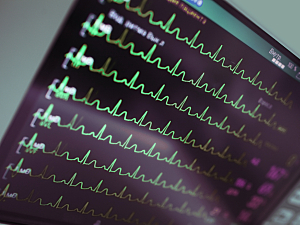Brigham and Women’s Hospital has a long history of harnessing the power of electricity in medicine. From Dr. Harvey William Cushing’s innovative use of electrosurgery in the 1920s to the present, the Brigham has continually offered patients treatment options that are not available elsewhere.
Today, pioneering cardiologists at Brigham’s Heart & Vascular Center are correcting heart rhythm disorders using a variety of electrophysiology-based treatments to relieve patients’ suffering, improve their quality of life and save lives.
William Henry Sauer, MD, section chief for the Cardiac Arrhythmia Service, became interested in the field early in his career. “I had a background in engineering, and during medical school, I became fascinated with the idea of how the body creates electricity and how the heart uses electricity to function,” he says.
Dr. Sauer now leads a multidisciplinary team of electrophysiologists, nurses, physician assistants, technicians, fellows and research assistants in the exclusive care of patients with arrhythmias such as irregular heart rhythms, heart palpitations and rapid heartbeats.
Patient Safety Starts With a Team Approach
According to Dr. Sauer, patient safety is the primary driver behind the Brigham’s team approach. He says the team meets every morning to discuss every case and solicit feedback from all members — an uncommon practice. This culture of patient safety is inculcated in team members from the very beginning, during residency and one of the field’s most robust fellowship programs, which is teaching the next generation of electrophysiologists.
“Treatment of arrhythmia is complex, and at the Brigham, we emphasize safety over speed or volume of cases,” he says. “For every single patient, we factor in the time to carefully consider patient safety, and there are never any pressures or incentives to compromise that safety.”
Offering a Variety of Catheter Ablation Technologies and Procedures
The Brigham cares for cardiac arrhythmia patients using a variety of catheter ablation techniques and strategies. Brigham investigators have developed new methods for applying radiofrequency (RF) ablation energy to enhance the safety and efficacy of these procedures. By leveraging differences in resistive and conductive heating of tissue and utilizing ways to improve the efficiency of RF energy delivery, Brigham electrophysiologists can customize and tailor an ablation procedure for each individual patient.
In addition to traditional RF ablation and cryoablation, Brigham electrophysiologists are studying energy sources like pulsed-field ablation, a new form of energy-based technology in the investigational stage. In addition, the Brigham continues to investigate needle ablation catheter technology developed by Brigham faculty members to treat refractory ventricular arrhythmias.
Furthermore, the Brigham pioneered stereotactic body radiation therapy and is one of the few institutions to offer this therapy. The treatment, which is also used to target tumors, employs imaging-based techniques to perform noninvasive heart ablations for ventricular arrhythmias.
Implantable Device Use
Brigham electrophysiologists are changing the way pacemakers are implanted by using conduction system pacing to stimulate the heart to conduct electricity through its natural electrical pathways. Physicians perform leadless pacing, which uses a self-contained, pellet-like device to avoid the need for a pulse generator implantation. The Cardiac Arrhythmia Service is also pioneering new techniques for cardiac resynchronization therapy, which uses a lead placed in a coronary vein overlying the heart to help ventricles beat more efficiently.
“Proper programming for these implantable devices has been shown to reduce heart failure symptoms and preserve and improve heart function,” Dr. Sauer says. “At the Brigham, we have developed special modes of pacemaker programming that minimize ventricular pacing to preserve cardiac function.”
Digital Health Enables Same-Day Discharge and Home Virtual Visits
Dr. Sauer notes that the field of cardiac electrophysiology is one of the leading medical specialties to use digital platforms to monitor and care for patients remotely. Virtual health platforms, with remote monitoring technology developed at the Brigham, are having a lasting impact on how patients are cared for.
For example, the Brigham has a unique, same-day discharge program in which patients are sent home with an electrocardiographic recording device, blood pressure cuff and pulse oximeter to monitor their condition around the clock before a virtual follow-up the next day. The use of these technologies also enables cardiac electrophysiologists to conduct virtual visits where patients consult with their providers at home.
The virtual visit and same-day discharge programs build upon an already robust remote-device monitoring program for patients with implanted devices for cardiac rhythm management.
“We can collect a significant amount of meaningful data from implanted devices like pacemakers and defibrillators without any burden on patients,” Dr. Sauer says. “This data allows us to have more meaningful telehealth visits and helps us identify problems earlier to improve outcomes.”
